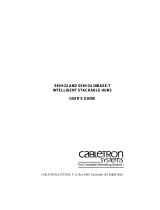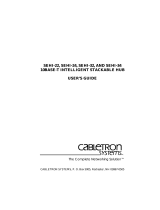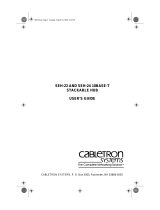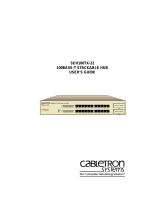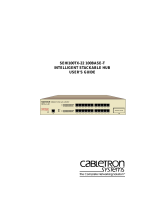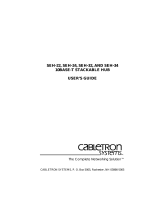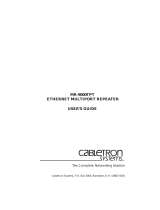Page is loading ...

SEHI-22FL
INTELLIGENT STACKABLE HUB
USER’S GUIDE
SEHI Book Page 1 Friday, April 19, 1996 10:46 AM

SEHI User’s Guide i
NOTICE
Cabletron Systems reserves the right to make changes in specifications and other information
contained in this document without prior notice. The reader should in all cases consult Cabletron
Systems to determine whether any such changes have been made.
The hardware, firmware, or software described in this manual is subject to change without notice.
IN NO EVENT SHALL CABLETRON SYSTEMS BE LIABLE FOR ANY INCIDENTAL,
INDIRECT, SPECIAL, OR CONSEQUENTIAL DAMAGES WHATSOEVER (INCLUDING BUT
NOT LIMITED TO LOST PROFITS) ARISING OUT OF OR RELATED TO THIS MANUAL OR
THE INFORMATION CONTAINED IN IT, EVEN IF CABLETRON SYSTEMS HAS BEEN
ADVISED OF, KNOWN, OR SHOULD HAVE KNOWN, THE POSSIBILITY OF SUCH
DAMAGES.
Copyright 1996 by Cabletron Systems, Inc., P.O. Box 5005, Rochester, NH 03866-5005
All Rights Reserved
Printed in the United States of America
Order Number: 9031652-01 April 1996
SPECTRUM
,
LANVIEW
,
MicroMMAC
, and
BRIM
are registered trademarks and
Element
Manager
,
EPIM
,
EPIM-A
,
EPIM-F1
,
EPIM-F2
,
EPIM-F3
,
EPIM-T
,
EPIM-X
,
FOT-F
,
FOT-F3
,
HubSTACK
,
SEH
,
SEHI
, and
TMS-3
are trademarks of Cabletron Systems, Inc.
All other product names mentioned in this manual may be trademarks or registered trademarks of
their respective companies.
Printed on Recycled Paper
SEHI Book Page i Friday, April 19, 1996 10:46 AM

Notice
ii SEHI User’s Guide
FCC NOTICE
This device complies with Part 15 of the FCC rules. Operation is subject to the following two
conditions: (1) this device may not cause harmful interference, and (2) this device must accept any
interference received, including interference that may cause undesired operation.
NOTE:
This equipment has been tested and found to comply with the limits for a Class A digital
device, pursuant to Part 15 of the FCC rules. These limits are designed to provide reasonable
protection against harmful interference when the equipment is operated in a commercial environment.
This equipment uses, generates, and can radiate radio frequency energy and if not installed in
accordance with the operator’s manual, may cause harmful interference to radio communications.
Operation of this equipment in a residential area is likely to cause interference in which case the user
will be required to correct the interference at his own expense.
WARNING:
Changes or modifications made to this device which are not expressly approved by the
party responsible for compliance could void the user’s authority to operate the equipment.
DOC NOTICE
This digital apparatus does not exceed the Class A limits for radio noise emissions from digital
apparatus set out in the Radio Interference Regulations of the Canadian Department of
Communications.
Le présent appareil numérique n’émet pas de bruits radioélectriques dépassant les limites applicables
aux appareils numériques de la class A prescrites dans le Règlement sur le brouillage radioélectrique
édicté par le ministère des Communications du Canada.
VCCI NOTICE
This equipment is in the 1st Class Category (information equipment to be used in commercial and/or
industrial areas) and conforms to the standards set by the Voluntary Control Council for Interference
by Information Technology Equipment (VCCI) aimed at preventing radio interference in commercial
and/or industrial areas.
Consequently, when used in a residential area or in an adjacent area thereto, radio interference may be
caused to radios and TV receivers, etc.
Read the instructions for correct handling.
SEHI Book Page ii Friday, April 19, 1996 10:46 AM

Notice
SEHI User’s Guide iii
CABLETRON SYSTEMS, INC. PROGRAM LICENSE AGREEMENT
IMPORTANT:
Before utilizing this product, carefully read this License Agreement.
This document is an agreement between you, the end user, and Cabletron Systems, Inc. (“Cabletron”)
that sets forth your rights and obligations with respect to the Cabletron software program (the
“Program”) contained in this package. The Program may be contained in firmware, chips or other
media. BY UTILIZING THE ENCLOSED PRODUCT, YOU ARE AGREEING TO BECOME
BOUND BY THE TERMS OF THIS AGREEMENT, WHICH INCLUDES THE LICENSE AND
THE LIMITATION OF WARRANTY AND DISCLAIMER OF LIABILITY. IF YOU DO NOT
AGREE TO THE TERMS OF THIS AGREEMENT, PROMPTLY RETURN THE UNUSED
PRODUCT TO THE PLACE OF PURCHASE FOR A FULL REFUND.
CABLETRON SOFTWARE PROGRAM LICENSE
1. LICENSE
. You have the right to use only the one (1) copy of the Program provided in this
package subject to the terms and conditions of this License Agreement.
You may not copy, reproduce or transmit any part of the Program except as permitted by the
Copyright Act of the United States or as authorized in writing by Cabletron.
2. OTHER RESTRICTIONS. You may not reverse engineer, decompile, or disassemble the
Program.
3. APPLICABLE LAW. This License Agreement shall be interpreted and governed under the laws
and in the state and federal courts of New Hampshire. You accept the personal jurisdiction and
venue of the New Hampshire courts.
EXCLUSION OF WARRANTY AND DISCLAIMER OF LIABILITY
1. EXCLUSION OF
WARRANTY. Except as may be specifically provided by Cabletron in
writing, Cabletron makes no warranty, expressed or implied, concerning the Program (including
its documentation and media).
CABLETRON DISCLAIMS ALL WARRANTIES, OTHER THAN THOSE SUPPLIED TO
YOU BY CABLETRON IN WRITING, EITHER EXPRESSED OR IMPLIED, INCLUDING
BUT NOT LIMITED TO IMPLIED WARRANTIES OF MERCHANTABILITY AND
FITNESS FOR A PARTICULAR PURPOSE, WITH RESPECT TO THE PROGRAM, THE
ACCOMPANYING WRITTEN MATERIALS, AND ANY ACCOMPANYING HARDWARE.
2. NO LIABILITY FOR CONSEQUENTIAL DAMAGES. IN NO EVENT SHALL
CABLETRON OR ITS SUPPLIERS BE LIABLE FOR ANY DAMAGES WHATSOEVER
(INCLUDING, WITHOUT LIMITATION, DAMAGES FOR LOSS OF BUSINESS,
PROFITS, BUSINESS INTERRUPTION, LOSS OF BUSINESS INFORMATION, SPECIAL,
INCIDENTAL, CONSEQUENTIAL, OR RELIANCE DAMAGES, OR OTHER LOSS)
ARISING OUT OF THE USE OR INABILITY TO USE THIS CABLETRON PRODUCT,
EVEN IF CABLETRON HAS BEEN ADVISED OF THE POSSIBILITY OF SUCH
DAMAGES. BECAUSE SOME STATES DO NOT ALLOW THE EXCLUSION OR
LIMITATION OF LIABILITY FOR CONSEQUENTIAL OR INCIDENTAL DAMAGES, OR
ON THE DURATION OR LIMITATION OF IMPLIED WARRANTIES, IN SOME
INSTANCES THE ABOVE LIMITATIONS AND EXCLUSIONS MAY NOT APPLY TO
YOU.
SEHI Book Page iii Friday, April 19, 1996 10:46 AM

Notice
iv SEHI User’s Guide
UNITED STATES GOVERNMENT RESTRICTED RIGHTS
The enclosed product (a) was developed solely at private expense; (b) contains “restricted computer
software” submitted with restricted rights in accordance with Section 52227-19 (a) through (d) of the
Commercial Computer Software - Restricted Rights Clause and its successors, and (c) in all respects
is proprietary data belonging to Cabletron and/or its suppliers.
For Department of Defense units, the product is licensed with “Restricted Rights” as defined in the
DoD Supplement to the Federal Acquisition Regulations, Section 52.227-7013 (c) (1) (ii) and its
successors, and use, duplication, disclosure by the Government is subject to restrictions as set forth in
subparagraph (c) (1) (ii) of the Rights in Technical Data and Computer Software clause at
252.227-7013. Cabletron Systems, Inc., 35 Industrial Way, Rochester, New Hampshire 03867-0505.
SEHI Book Page iv Friday, April 19, 1996 10:46 AM

SEHI User’s Guide v
CONTENTS
CHAPTER 1 INTRODUCTION
1.1 Using This Manual.......................................................................1-1
1.2 Document Conventions...............................................................1-2
1.3 Getting Help.................................................................................1-3
1.4 Related Manuals..........................................................................1-3
CHAPTER 2 SEHI FEATURES AND OPTIONS
2.1 SEHI Overview............................................................................2-2
2.2 SEHI Features.............................................................................2-2
2.3 Stackable Capabilities.................................................................2-3
2.4 Remote Network Management Capabilities................................2-3
2.5 Optional Features........................................................................2-4
CHAPTER 3 INSTALLATION REQUIREMENTS AND
SPECIFICATIONS
3.1 Cable Specifications....................................................................3-1
3.1.1 HubSTACK Interconnect Cable Requirements...............3-2
3.1.2 10BASE-FL Fiber Optic Network Requirements.............3-2
3.1.3 10BASE-T UTP and STP Cable Specifications..............3-3
3.2 Network Port Specifications.........................................................3-4
3.3 COM Port Requirements.............................................................3-5
3.4 Transceiver Requirements ..........................................................3-5
3.5 Operating Specifications..............................................................3-6
3.6 Power Supply Requirements.......................................................3-7
3.7 Environmental Requirements......................................................3-8
3.8 Agency Approvals........................................................................3-8
3.8.1 Safety..............................................................................3-8
3.8.2 Immunity .........................................................................3-8
3.8.3 Emission .........................................................................3-8
3.9 Physical Specifications................................................................3-8
SEHI Book Page v Friday, April 19, 1996 10:46 AM

Contents
vi SEHI User’s Guide
CHAPTER 4 INSTALLATION
4.1 Unpacking the SEHI.....................................................................4-1
4.2 Pre-installation Test .....................................................................4-2
4.3 Installing the SEHI .......................................................................4-2
4.3.1 Tabletop or Shelf Installation...........................................4-3
4.3.2 Rackmount Installation....................................................4-4
4.3.3 Stacking the SEHI...........................................................4-6
4.4 Connecting the SEHI to the Power Source..................................4-8
4.5 Adding/Replacing EPIMs .............................................................4-9
CHAPTER 5 CONNECTING TO THE NETWORK
5.1 Connecting the SEHI to the Network ...........................................5-1
5.1.1 Connecting Network Ports...............................................5-1
5.1.2 Connecting a UTP Segment to an EPIM-T .....................5-4
5.1.3 Connecting a Fiber Segment to an EPIM-F1/F2/F3........5-5
5.1.4 Connecting a Thin Coaxial Segment to an EPIM-C........5-8
5.1.5 Connecting an AUI Cable to an EPIM-A .........................5-9
5.1.6 Connecting an AUI Cable to an EPIM-X .......................5-11
5.2 FInishing the Installation ............................................................5-12
CHAPTER 6 TROUBLESHOOTING
6.1 Installation CheckOut...................................................................6-1
6.2 Using LANVIEW...........................................................................6-2
6.3 Using the RESET Button .............................................................6-4
6.4 Setting the NVRAM Switch ..........................................................6-5
CHAPTER 7 LOCAL MANAGEMENT
7.1 Local Management Keyboard Conventions.................................7-2
7.2 Management Terminal Setup.......................................................7-3
7.3 Accessing Local Management.....................................................7-6
7.4 The Feature Selection Screen .....................................................7-7
7.5 The Community Name Table Screen...........................................7-8
7.6 The Configuration Screen..........................................................7-10
7.7 The Trap Table Screen..............................................................7-14
7.8 The SNMP Tools Screen ...........................................................7-16
7.9 The Device Statistics Screen.....................................................7-20
SEHI Book Page vi Friday, April 19, 1996 10:46 AM

Contents
SEHI User’s Guide vii
APPENDIX A EPIM INFORMATION
A.1 EPIM Specifications.....................................................................A-1
A.1.1 EPIM-T............................................................................A-1
A.1.2 EPIM-F1 and EPIM-F2....................................................A-2
A.1.3 EPIM-F3..........................................................................A-3
A.1.4 EPIM-C............................................................................A-4
A.1.5 EPIM-A and EPIM-X (AUI Port) ......................................A-5
APPENDIX B IMAGE FILE DOWNLOAD USING OIDs
B.1 Setting up a UNIX Workstation as a TFTP Server ......................B-2
B.2 Standard TFTP Download...........................................................B-3
INDEX
SEHI Book Page vii Friday, April 19, 1996 10:46 AM

SEHI User’s Guide 1-1
CHAPTER 1
INTRODUCTION
Welcome to the Cabletron Systems
SEHI-22FL Intelligent Stackable
Hub User’s Guide
. This manual provides installation instructions and
reference information for the SEHI-22FL.
1.1 USING THIS MANUAL
Read through this manual to gain an understanding of the features and
capabilities of the SEHI. A general knowledge of Ethernet and IEEE
802.3 type data communications networks and their physical layer
components is helpful when installing the SEHI.
Chapter 1,
Introduction
, outlines the contents of this manual, describes
document conventions, provides getting help information and concludes
with a list of related manuals.
Chapter 2,
SEHI Features and Options
, details the features of the SEHI
and provides information about available options including EPIMs
(Ethernet Port Interface Modules) and HubSTACK interconnect cables.
Chapter 3,
Installation Requirements and Specifications
, describes
installation requirements, network guidelines, and SEHI operating
specifications.
Chapter 4,
Installation
, contains instructions for installing the SEHI as a
stackable or standalone hub.
Chapter 5,
Connecting to the Network
, explains how to connect the
SEHI to the network using the various media types.
Chapter 6,
Troubleshooting
, describes how to use the LANVIEW LEDs
to troubleshoot network problems.
NOTE
The term SEHI (Stackable Ethernet Hub with Intelligence) is
used throughout this manual when describing the features and
functions of the SEHI-22FL.
SEHI Book Page 1 Friday, April 19, 1996 10:46 AM

Chapter 1:
Introduction
1-2 SEHI User’s Guide
Chapter 7,
Local Management
, describes how to use SEHI Local
Management screens and the available commands.
Appendix A,
EPIM Information
, provides specifications, cabling
information, and switch settings for the Ethernet Port Interface Modules.
Appendix B,
Image File Download Using OIDs
, provides instructions
for setting up a TFTP server and downloading image files to the SEHI by
setting specific MIB OID strings.
1.2 DOCUMENT CONVENTIONS
The following conventions are used throughout this document:
NOTE
Note
symbol. Calls the reader’s attention to any item of
information that may be of special importance.
TIP
Tip
symbol. Conveys helpful hints concerning procedures or
actions.
!
CAUTION
Caution
symbol. Contains information essential to avoid
damage to the equipment.
Warning
symbol. Warns against an action that could result in
equipment damage, personal injury or death.
SEHI Book Page 2 Friday, April 19, 1996 10:46 AM

Getting Help
SEHI User’s Guide 1-3
1.3 GETTING HELP
If you need additional support related to this device, or if you have any
questions, comments, or suggestions concerning this manual, contact
Cabletron Systems Technical Support:
By phone (603) 332-9400
Monday – Friday; 8
A
.
M
. – 8
P
.
M
. Eastern Time
By CompuServe GO CTRON from any ! prompt
By Internet mail [email protected]
By FTP ctron.com (134.141.197.25)
Login
anonymous
Password
your email address
Before calling Cabletron Systems Technical Support, have the following
information ready:
• A description of the failure
• A description of any action(s) already taken to resolve the problem
(e.g., changing mode switches, rebooting the unit, etc.)
• A description of your network environment (layout, cable type, etc.)
• Network load and frame size at the time of trouble (if known)
• The serial and revision numbers of all Cabletron Systems products in
the network
• The device history (i.e., have you returned the device before, is this a
recurring problem, etc.)
• Any previous Return Material Authorization (RMA) numbers
1.4 RELATED MANUALS
Use the Cabletron Systems
SEH-22FL Stackable Hub User’s Guide
to
supplement the procedures and other technical data provided in this
manual. The procedures contained in the
SEH-22FL Stackable Hub
User’s Guide
are referenced where appropriate, but not repeated in this
manual.
SEHI Book Page 3 Friday, April 19, 1996 10:46 AM

SEHI User’s Guide 2-1
CHAPTER 2
SEHI FEATURES AND OPTIONS
This chapter provides an overview of the SEHI-22FL and contains
sections detailing features and available options.
Figure 2-1 Front and Rear Views of the SEHI-22FL
NOTE
The term SEHI (Stackable Ethernet Hub with Intelligence) is
used throughout this manual when describing features and
functions of the SEHI-22FL.
SEH INTERCONNECT
SEHI-22FL 100BASE-FL HUB WITH LANVIEW®
OUT
165212
HubSTACK
10BASE-FL HUB WITH LANVIEW
®
SECURE
SEHI-22FL
E
1
RCV
LNK
12 11 10 9 8 7 6 5 4 3 2 1
PWR
CPU
CLN
RX
TX
RX
TX
RX
TX
RX
TX
RX
TX
RX
TX
RX
TX
RX
TX
RX
TX
RX
TX
RX
TX
RX
TX
1
2
3
4
56
7
8
9
10
1112
EPIM 1
RESET
COM
Port Status LEDs
System LEDs
COM Port
RESET Button
Network Ports 1-12
EPIM Slot
Power Supply
ON/OFF Switch
Interconnect Bus "OUT" Port
FRONT VIEW
REAR VIEW
SEHI Book Page 1 Friday, April 19, 1996 10:46 AM

Chapter 2:
SEHI Features and Options
2-2 SEHI User’s Guide
2.1 SEHI OVERVIEW
The SEHI-22FL is an intelligent repeating hub providing front panel ports
for network connections and a rear panel HubSTACK Interconnect Bus
port for stackable connections. The SEHI is designed to manage the
Cabletron Systems SEH series of non-intelligent stackable hubs.
The SEHI-22FL provides twelve 10BASE-FL ST-type fiber optic ports
and one EPIM (Ethernet Port Interface Module) port.
2.2 SEHI FEATURES
This section provides detailed information about SEHI features and
capabilities.
Repeater Functionality
The SEHI fully conforms to the IEEE 802.3 10BASE-FL specifications,
and provides the flexibility to connect networks using IEEE 802.3,
Ethernet Version 1 or Version 2 equipment. The SEHI transmits retimed
data packets, regenerates the preamble, extends fragments, and arbitrates
collisions.
The SEHI automatically partitions problem segments, and reconnects
repaired segments to the network. This feature minimizes the impact on
network operation resulting from a problem on one segment by isolating
the problem segment. Only devices on the problem segment are affected.
When the problem is solved, the SEHI automatically reconnects the
isolated segment to the network.
FLASH EEPROMs
The SEHI uses FLASH EEPROMs that allow the downloading of new
and updated firmware using Cabletron Systems SPECTRUM Element
Manager/Windows or any device using BOOTP or TFTP protocols.
LANVIEW LEDs
Cabletron Systems LANVIEW Status Monitoring and Diagnostics
System is a troubleshooting tool that helps in diagnosing power failures,
collisions, cable faults, and link problems. The LANVIEW LEDs are
conveniently located on the SEHI front panel.
SEHI Book Page 2 Friday, April 19, 1996 10:46 AM

Stackable Capabilities
SEHI User’s Guide 2-3
RESET Button
Resetting the hub with the front panel RESET button reboots the SEHI
and initializes the processor.
Local Management
Manage the SEHI and attached segments through Local Management on
the SEHI. Local Management provides full packet and error statistics for
the entire stack, individual device, or individual port. Access Local
Management by attaching a DEC VT320 terminal or a PC using VT320
emulation software to the SEHI RJ45 COM port.
2.3 STACKABLE CAPABILITIES
The SEHI intelligent hub is designed to manage the Cabletron Systems
series of SEH non-intelligent hubs. The SEHI serves as the logical “top”
of the stack. It manages all SEH hubs in the stack providing full packet
and error statistics for the entire stack, individual device, or individual
port.
Stack up to four SEH non-intelligent hubs with one SEHI using Cabletron
Systems external HubSTACK Interconnect cables. Stackable
configurations make it possible to maintain only one IEEE repeater hop
while providing up to 130 10BASE-T Ethernet ports. Add or remove hubs
from the stack without powering down.
2.4 REMOTE NETWORK MANAGEMENT
CAPABILITIES
Manage the SEHI remotely with any SNMP network management
system. Cabletron Systems offers the following remote management
packages:
• Cabletron Systems SPECTRUM
• Cabletron Systems SPECTRUM Element Manager/Windows
• Cabletron Systems Remote SPECTRUM Portable Management
Applications
• Third Party SNMP compliant Network Management Packages
SEHI Book Page 3 Friday, April 19, 1996 10:46 AM

Chapter 2:
SEHI Features and Options
2-4 SEHI User’s Guide
2.5 OPTIONAL FEATURES
The following features are not included with the SEHI, but are purchased
separately from Cabletron Systems.
Ethernet Port Interface Modules (EPIMs)
EPIMs enable the expansion of the network through a variety of media.
Cabletron Systems offers the EPIMs shown in Table 2-1.
HubSTACK Interconnect Cables
Stack hubs together with Cabletron Systems HubSTACK Interconnect
cables. Table 2-2 lists the part number and the application for each cable.
Rack Mount Hardware
The SEHI can be installed in a 19-inch rack. Cabletron offers an
accessory package that includes brackets and mounting screws. The part
number for the accessory package is SEHI-ACCY-KIT.
Table 2-1 EPIMs
EPIM Media Type Connector
EPIM-A AUI DB15 (Female)
EPIM-C 10BASE2 Thin Coaxial BNC
EPIM-T
10BASE-T Unshielded Twisted
Pair
RJ45
EPIM-X Standard Transceiver DB15 (Male)
EPIM-F1 Multimode Fiber SMA
EPIM-F2 Multimode Fiber ST
EPIM-F3 Single Mode Fiber ST
Table 2-2 HubSTACK Interconnect Cables
P/N Description Application
9380110
12" HubSTACK
Interconnect Cable
SEH to SEH connections.
9380111
18" HubSTACK
Interconnect Cable
SEHI to SEH connections.
SEHI Book Page 4 Friday, April 19, 1996 10:46 AM

SEHI User’s Guide 3-1
CHAPTER 3
INSTALLATION REQUIREMENTS AND
SPECIFICATIONS
This chapter describes cabling requirements, network guidelines, and
operating specifications for the SEHI.
The network must meet the requirements and conditions specified in this
chapter to obtain satisfactory performance from this equipment. Failure to
follow these guidelines can result in poor network performance.
3.1 CABLE SPECIFICATIONS
The SEHI-22FL network ports support 10BASE-FL Multimode Fiber
Optic cabling.
Ethernet Port Interface Modules (EPIMs) expand a network using
Unshielded Twisted Pair (UTP), Shielded Twisted Pair (STP), Multimode
Fiber Optic, Single Mode Fiber Optic, or Thin Coaxial cabling. For
information concerning EPIMs, refer to Appendix A.
The rear panel Interconnect Bus port supports Cabletron Systems
HubSTACK Interconnect cables for stackable applications.
Take care in planning and preparing the network cabling and connections.
The quality of the connections and the length of cables are critical factors
in determining the reliability of the network. The following sections
provide the specifications for each media type.
!
CAUTION
The network must meet the requirements and conditions
specified in this chapter to obtain satisfactory performance from
this equipment. Failure to follow these guidelines can result in
poor network performance.
SEHI Book Page 1 Friday, April 19, 1996 10:46 AM

Chapter 3: Installation Requirements and Specifications
3-2 SEHI User’s Guide
3.1.1 HubSTACK Interconnect Cable Requirements
Attach the SEHI to modules in the stack with the SEHI HubSTACK
Interconnect cable available only from Cabletron Systems. Refer to
Chapter 1 for cable part numbers. The cable attaches to the SEHI rear
panel bus port.
The rear panel of the SEHI has an Interconnect Bus Out port (male
connector) to stack SEH non-intelligent hubs together. Stack up to four
SEH hubs together with one SEHI.
3.1.2 10BASE-FL Fiber Optic Network Requirements
Table 3-1 shows Multimode Fiber Optic Cable specifications for the
SEHI-22FL.
Attenuation
Test the fiber optic cable with a fiber optic attenuation test set adjusted for
an 850 nm wavelength. This test verifies that the signal loss in a cable is
within an acceptable level. Table 3-1 shows the attenuation for each
Multimode cable type.
Fiber Optic Budget and Propagation Delay
Determine the maximum fiber optic cable length by calculating the fiber
optic budget delay and total network propagation before the fiber optic
cable runs are incorporated into a network design.
Fiber optic budget is the combination of the optical loss due to the fiber
optic cable, in-line splices, and fiber optic connectors.
Propagation delay is the amount of time it takes data to travel from the
sending device to the receiving device. Total propagation delay allowed
for the network is 25.6 µs (51.2 µs roundtrip). If the total propagation
delay between any two nodes on the network exceeds 25.6 µs, then use
bridges.
Table 3-1 Multimode Fiber Optic Cable Specifications
Cable Type Attenuation Maximum Cable Length
50/125 µm 13.0 dB or less Maximum fiber optic cable length is 2
km (2187.2 yds). However, IEEE 802.3
specifications allow for a maximum of 1
km (1093.6 yds).
62.5/125 µm 16.0 dB or less
100/140 µm 19.0 dB or less
SEHI Book Page 2 Friday, April 19, 1996 10:46 AM

Cable Specifications
SEHI User’s Guide 3-3
3.1.3 10BASE-T UTP and STP Cable Specifications
The devices and 10BASE-T Twisted Pair Segments connected to an SEHI
EPIM-T module must meet the IEEE 802.3 10BASE-T specifications
shown below:
Length
The IEEE 802.3 10BASE-T standard requires that 10BASE-T devices
transmit over a 100 meter (328 foot) link using 22-24 AWG Unshielded
Twisted Pair (UTP) wire. However, cable quality largely determines the
maximum link length. With high quality, low attenuation cable, link
lengths of up to 200 meters are achievable. Cable delay limits the
maximum link length to 200 meters, regardless of the cable type.
Insertion Loss
The maximum insertion loss allowed for a 10BASE-T link is 11.5 dB at
all frequencies between 5.0 and 10 MHz. This includes the attenuation of
the cables, connectors, patch panels, and reflection losses due to
impedance mismatches in the link segment.
Impedance
Cabletron Systems 10BASE-T Twisted Pair products work on twisted pair
cable with 75 to 165 ohms impedance. UTP cables typically have an
impedance of 85 to 110 ohms.
Shielded Twisted Pair (STP) cables, such as IBM Type 1 cable, are also
used. The impedance of IBM Type 1 cable is typically 150 ohms. Higher
impedance increases signal reflection, but because the cable is shielded,
signal reflection has little effect on the quality of the received signal due
to the lack of crosstalk between the shielded cable pairs.
Jitter
Intersymbol interference and reflections cause jitter in the bit cell timing,
resulting in data errors. A 10BASE-T link must not generate more than
5.0 ns of jitter. If the cable meets the impedance requirements for a
10BASE-T link, jitter should not be a concern.
Delay
The maximum propagation delay of a 10BASE-T link segment must not
exceed 1000 ns. This 1000 ns maximum delay limits the maximum link
segment length to no greater than 200 meters.
SEHI Book Page 3 Friday, April 19, 1996 10:46 AM

Chapter 3: Installation Requirements and Specifications
3-4 SEHI User’s Guide
Crosstalk
Crosstalk is caused by signal coupling between the different cable pairs
contained within a multi-pair cable bundle. 10BASE-T transceivers are
designed so that the user does not need to be concerned about cable
crosstalk, provided the cable meets all other requirements.
Noise
Noise is caused by either crosstalk or externally induced impulses.
Impulse noise may cause data errors if the impulses occur at very specific
times during data transmission. Generally, the user need not be concerned
about noise. If noise-related data errors are suspected, it may be necessary
to either reroute the cable or eliminate the source of the impulse noise.
Temperature
Multi-pair PVC 24 AWG cables typically have an attenuation of
8 dB to 10 dB/100 meters at 20°C (68°F). The attenuation of PVC
insulated cable varies significantly with temperature. At temperatures
greater than 40°C (104°F), Cabletron Systems recommends the use of
plenum-rated cables to ensure that cable attenuation remains within
specification.
3.2 NETWORK PORT SPECIFICATIONS
The SEHI-22FL provides ST-type ports for 10BASE-FL Multimode Fiber
Optic cabling. Figure 3-1 shows the network ports.
Figure 3-1 SEHI-22FL Network Ports
RX
TX
RX
TX
RX
TX
RX
TX
RX
TX
RX
TX
7
8
9
10
1112
RX
TX
RX
TX
RX
TX
RX
TX
RX
TX
RX
TX
1
2
3
4
56
09162_04
SEHI Book Page 4 Friday, April 19, 1996 10:46 AM

COM Port Requirements
SEHI User’s Guide 3-5
3.3 COM PORT REQUIREMENTS
The RJ45 COM port supports access to a Local Management Console.
The Console port supports a Digital Equipment Corporation, VT320
terminal or PC emulation of the VT320 terminal. Figure 3-2 shows the
pinouts for the RJ45 COM port.
Figure 3-2 COM Port Pinouts
3.4 TRANSCEIVER REQUIREMENTS
When connecting an external network segment through a transceiver to
the SEHI with an EPIM-A, the following requirements must be met:
• The transceiver or Ethernet device to which the module is connected
must meet IEEE 802.3 standards, and/or Ethernet Version 1.0 or
Version 2.0 standards.
• The Signal Quality Error (SQE) test function on the transceiver must
be disabled when it is connected to a repeater or to an Ethernet Version
1.0 device. In addition, some Version 2.0 equipment does not support
the SQE test. Devices that do not support the SQE test interpret the
SQE test pulse as a collision.
1. Transmit Data
2. Data Carrier Detect
3. Data Set Ready
4. Receive Data
5. Signal Ground
6. Data Terminal Ready
7. Request To Send
8. Clear To Send
1 2 3 4 5 6 7 8
COM
165201
SEHI Book Page 5 Friday, April 19, 1996 10:46 AM
/
